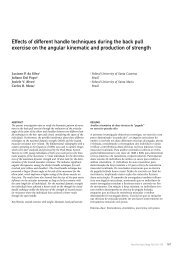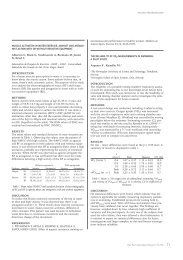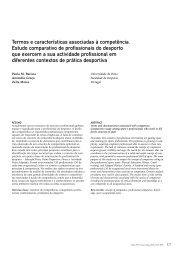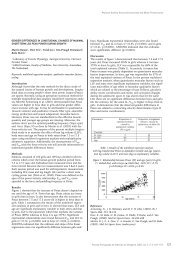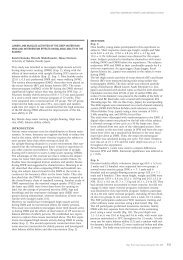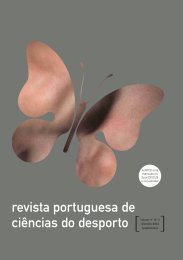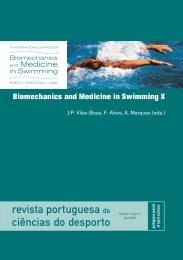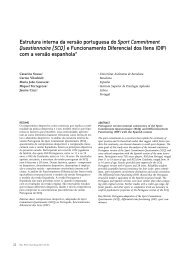35754-Revista FCDEF - Faculdade de Desporto da Universidade do ...
35754-Revista FCDEF - Faculdade de Desporto da Universidade do ...
35754-Revista FCDEF - Faculdade de Desporto da Universidade do ...
You also want an ePaper? Increase the reach of your titles
YUMPU automatically turns print PDFs into web optimized ePapers that Google loves.
Os parâmetros <strong>da</strong> análise <strong>de</strong> regressão múltipla encontra<strong>do</strong>s a<br />
partir <strong>da</strong> associação entre valores estima<strong>do</strong>s <strong>de</strong> VO2max e<br />
informações relaciona<strong>da</strong>s aos níveis <strong>de</strong> prática <strong>de</strong> ativi<strong>da</strong><strong>de</strong> física<br />
habitual, apesar <strong>de</strong> <strong>de</strong>stacarem idêntica variável preditora<br />
para moças e rapazes, o que parece refletir mecanismo <strong>de</strong><br />
influência semelhante, apontam diferenças inter-sexos importantes<br />
quanto à magnitu<strong>de</strong> <strong>da</strong> capaci<strong>da</strong><strong>de</strong> <strong>de</strong> explicação.<br />
Nesse particular, aspecto que merece atenção refere-se ao fato<br />
<strong>da</strong>s informações quanto à DEtotal terem si<strong>do</strong> aban<strong>do</strong>na<strong>da</strong>s<br />
quan<strong>do</strong> <strong>da</strong> elaboração <strong>do</strong>s mo<strong>de</strong>los <strong>de</strong> regressão volta<strong>do</strong>s à<br />
explicação estatística <strong>da</strong>s variações nas estimativas <strong>do</strong>s valores<br />
<strong>de</strong> VO2max. Em vista disso, mesmo admitin<strong>do</strong> que a quanti<strong>da</strong><strong>de</strong><br />
<strong>de</strong> energia <strong>de</strong>spendi<strong>da</strong> durante o dia se mostrou diretamente<br />
<strong>de</strong>pen<strong>de</strong>nte <strong>da</strong> intensi<strong>da</strong><strong>de</strong> com que as ativi<strong>da</strong><strong>de</strong>s físicas são<br />
realiza<strong>da</strong>s, tu<strong>do</strong> indica que, para se alcançar maior impacto nos<br />
valores estima<strong>do</strong>s <strong>de</strong> VO2max, <strong>de</strong>ve-se priorizar sobretu<strong>do</strong> ativi<strong>da</strong><strong>de</strong>s<br />
físicas habitualmente realiza<strong>da</strong>s pelos a<strong>do</strong>lescentes envolven<strong>do</strong><br />
esforços físicos <strong>de</strong> mo<strong>de</strong>ra<strong>da</strong>-a-vigorosa intensi<strong>da</strong><strong>de</strong>.<br />
Apesar <strong>da</strong> significância estatística aponta<strong>da</strong> pelos mo<strong>de</strong>los <strong>de</strong><br />
regressão acha<strong>do</strong>s, <strong>de</strong> que a proporção <strong>de</strong> variação <strong>do</strong>s valores<br />
estima<strong>do</strong>s <strong>de</strong> VO2max, que po<strong>de</strong> ser explica<strong>da</strong> por informações<br />
quanto aos níveis <strong>de</strong> prática <strong>de</strong> ativi<strong>da</strong><strong>de</strong> física habitual, em<br />
sujeitos jovens, é relativamente baixa, e que outros componentes<br />
<strong>da</strong> aptidão física relaciona<strong>da</strong> à saú<strong>de</strong> não apresentam qualquer<br />
associação importante com a ativi<strong>da</strong><strong>de</strong> física habitual, <strong>de</strong>stacam<br />
a importância <strong>de</strong> se procurar distinguir entre níveis <strong>de</strong><br />
prática <strong>de</strong> ativi<strong>da</strong><strong>de</strong> física habitual e índices <strong>de</strong> aptidão física<br />
relaciona<strong>da</strong> à saú<strong>de</strong>. Via <strong>de</strong> regra, rotinas <strong>de</strong> avaliações volta<strong>da</strong>s<br />
à aptidão física relaciona<strong>da</strong> à saú<strong>de</strong> são utiliza<strong>da</strong>s em segmentos<br />
<strong>da</strong> população jovem, na tentativa <strong>de</strong> generalizar informações<br />
quanto aos níveis <strong>de</strong> prática <strong>de</strong> ativi<strong>da</strong><strong>de</strong> física habitual.<br />
Por conta <strong>da</strong> menor associação entre atributos volta<strong>do</strong>s à aptidão<br />
física e à ativi<strong>da</strong><strong>de</strong> física, parece que esta estratégia merece<br />
ser analisa<strong>da</strong> mais cui<strong>da</strong><strong>do</strong>samente.<br />
Outra repercussão importante proveniente <strong>do</strong>s acha<strong>do</strong>s <strong>do</strong> presente<br />
estu<strong>do</strong>, refere-se aos mo<strong>de</strong>los conceituais que procuram<br />
justificar relações observa<strong>da</strong>s entre ativi<strong>da</strong><strong>de</strong> física, aptidão física<br />
e saú<strong>de</strong>. Freqüentemente, assume-se o pressuposto no senti<strong>do</strong><br />
<strong>de</strong> que o impacto positivo para saú<strong>de</strong>, mediante prática <strong>de</strong><br />
ativi<strong>da</strong><strong>de</strong> física, é modula<strong>do</strong> por intermédio <strong>de</strong> modificações<br />
nos níveis <strong>de</strong> aptidão física. Assim, a prática habitual <strong>de</strong> ativi<strong>da</strong><strong>de</strong><br />
física ten<strong>de</strong> a interferir favoravelmente nos componentes<br />
<strong>da</strong> aptidão física, e, em conseqüência <strong>do</strong> aprimoramento <strong>de</strong>stes,<br />
<strong>de</strong>verá haver melhora no esta<strong>do</strong> <strong>de</strong> saú<strong>de</strong>. Uma menor associação<br />
entre níveis <strong>de</strong> prática <strong>de</strong> ativi<strong>da</strong><strong>de</strong> física habitual e indica<strong>do</strong>res<br />
<strong>do</strong>s componentes <strong>de</strong> aptidão física observa<strong>da</strong> entre a<strong>do</strong>lescentes<br />
po<strong>de</strong> suscitar dúvi<strong>da</strong>s se melhores condições <strong>de</strong><br />
saú<strong>de</strong>, induzi<strong>da</strong>s por níveis mais eleva<strong>do</strong>s <strong>de</strong> prática <strong>de</strong> ativi<strong>da</strong><strong>de</strong><br />
física habitual, são efetivamente alcança<strong>do</strong>s em conseqüência<br />
<strong>de</strong> ganhos nos índices <strong>de</strong> aptidão física. Provavelmente,<br />
supostas condições favoráveis <strong>de</strong> saú<strong>de</strong>, apresenta<strong>da</strong>s por a<strong>do</strong>lescentes<br />
mais ativos fisicamente possam ser atribuí<strong>da</strong>s a interação<br />
entre fatores inerentes ao estilo <strong>de</strong> vi<strong>da</strong> e aos atributos<br />
pessoais que po<strong>de</strong>m afetar a relação ativi<strong>da</strong><strong>de</strong> física-saú<strong>de</strong>.<br />
Referências bibliográficas<br />
BERTHOUZE SE; MINAIRE PM; CASTELLS J; BUSSO T; VICO<br />
L; LACOUR JR. (1995). Relationship between mean habitual<br />
<strong>da</strong>ily energy expenditure and maximal oxygen uptake.<br />
Medicine and Science in Sports and Exercise 27: 1170-9.<br />
BOUCHARD C; TREMBLAY A; LEBLANC C; LORTIE G;<br />
SAUARD R; THERIALT G. (1983). A method to assess<br />
energy expenditure in children and adults. American Journal<br />
of Clinical Nutrition 37:461-7.<br />
CASPERSEN CJ; POWELL KE; CHRISTENSEN GM (1985).<br />
Physical activity, exercise, and physical fitness: <strong>de</strong>finitions<br />
and distinctions for health-related research. Public Health<br />
Reports 100 (2)126-131.<br />
KATZMARZYK PT; MALINA RM; SONG TMK; BOUCHARD<br />
C. (1998) Physical activity and health-related fitness in<br />
youth: a multivariate analysis. Medicine and Science in Sports<br />
and Exercise 30:709-14.<br />
MALINA RM (1995). Physical activity and fitness of children<br />
and youth: questions and implications. Medicine, Exercise,<br />
Nutrition and Health 4:123-35.<br />
MORROW JR; FREEDSON PS. (1994). Relationships between<br />
habitual physical activity and aerobic fitness in a<strong>do</strong>lescents.<br />
Pediatric Exercise Science 6:315-29.<br />
<strong>da</strong>rta@sercomtel.com.br<br />
A EXPERIÊNCIA MOÇAMBICANA NA INVESTIGAÇÃO DA<br />
ACTIVIDADE FÍSICA HABITUAL.<br />
GRUPOS DE INTERESSE<br />
Prista, António<br />
Laboratório <strong>de</strong> Fisiologia <strong>do</strong> Exercício – DCD, Universi<strong>da</strong><strong>de</strong> Eduar<strong>do</strong><br />
Mondlane; <strong>Facul<strong>da</strong><strong>de</strong></strong> <strong>de</strong> Ciências <strong>de</strong> Educação Física e <strong>Desporto</strong>,<br />
Universi<strong>da</strong><strong>de</strong> Pe<strong>da</strong>gógica, Moçambique.<br />
Des<strong>de</strong> que o se<strong>de</strong>ntarismo tomou conta <strong>da</strong>s socie<strong>da</strong><strong>de</strong>s industrializa<strong>da</strong>s<br />
e as suas consequências se evi<strong>de</strong>nciaram ao nível <strong>da</strong><br />
saú<strong>de</strong> pública, os estu<strong>do</strong>s sobre a activi<strong>da</strong><strong>de</strong> física (AF) tornaram-se<br />
um imperativo <strong>da</strong> nossa espécie. Se no início as abor<strong>da</strong>gens<br />
antropológicas <strong>do</strong>minavam o olhar sobre os hábitos <strong>de</strong> AF,<br />
nos dias <strong>de</strong> hoje o estu<strong>do</strong> <strong>do</strong>s efeitos <strong>da</strong> inactivi<strong>da</strong><strong>de</strong> sobre a<br />
homeostasia tomaram um lugar privilegia<strong>do</strong> na investigação<br />
científica. A sistematização <strong>da</strong> enorme produção científica<br />
sugere que, no último século, o “Homo Urbanos” diminuiu o<br />
seu dispêndio energético diário entre 300 a 800 calorias por dia<br />
(James, 1995, Schoeller e Kushner, 1997). Utilizan<strong>do</strong> um valor<br />
médio, estes <strong>da</strong><strong>do</strong>s significam que, nas socie<strong>da</strong><strong>de</strong>s industrializa<strong>da</strong>s,<br />
estará a nossa espécie a <strong>de</strong>spen<strong>de</strong>r aproxima<strong>da</strong>mente<br />
menos 200 000 mil calorias por ano, o que dá, teoricamente, à<br />
volta <strong>de</strong> uma redução <strong>de</strong> 25 a 30 kg no dispêndio energético <strong>de</strong><br />
gordura. É pois razoável admitir que, <strong>do</strong> ponto <strong>de</strong> vista fisiológico<br />
mas não só, esta <strong>de</strong>sci<strong>da</strong> dramática <strong>de</strong> activi<strong>da</strong><strong>de</strong> explicará<br />
o chama<strong>do</strong> envelhecimento secundário provoca<strong>do</strong> pelas <strong>do</strong>enças<br />
hipocinéticas.<br />
Na perspectiva <strong>do</strong> conceito <strong>de</strong> saú<strong>de</strong> associa<strong>do</strong> à activi<strong>da</strong><strong>de</strong> física,<br />
e até a um passa<strong>do</strong> recente, o estu<strong>do</strong> <strong>da</strong> AF nos países <strong>do</strong><br />
chama<strong>do</strong> terceiro mun<strong>do</strong> pareceria supérfluo, <strong>da</strong><strong>do</strong> que a prevalência<br />
<strong>de</strong> <strong>do</strong>enças associa<strong>da</strong>s à inactivi<strong>da</strong><strong>de</strong> se apresenta<br />
mínima. Há contu<strong>do</strong> quem enten<strong>de</strong> que, neste caso, o estu<strong>do</strong><br />
<strong>da</strong> AF nestes países po<strong>de</strong> ser realiza<strong>do</strong> na perspectiva oposta à<br />
<strong>da</strong> sua ausência. Ou seja, adivinhan<strong>do</strong>-se a existência <strong>de</strong> populações<br />
activas, o terreno nestes países seria fértil para o estu<strong>do</strong><br />
<strong>da</strong>s associações livres <strong>do</strong> se<strong>de</strong>ntarismo.<br />
É assim que, embora em número limita<strong>do</strong>, a activi<strong>da</strong><strong>de</strong> física<br />
nos países <strong>do</strong> terceiro mun<strong>do</strong> tem si<strong>do</strong> estu<strong>da</strong><strong>da</strong>, quer em<br />
populações adultas (Bleiberg et al, 1980, 1981; Brun et al.,<br />
1981, Heini et al., 1996; Bhargava, 1997; Murayma e Ohtsuka,<br />
1994; Torun et al., 1996; Goran et al., 1998; Bénéfice, 1998;<br />
<strong>Revista</strong> Portuguesa <strong>de</strong> Ciências <strong>do</strong> <strong>Desporto</strong>, 2004, vol. 4, nº 2 (suplemento) [15–102] 25



